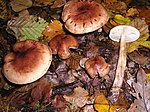

| Tricholoma | |
|---|---|

| |
| Tricholoma flavovirens | |
| Scientific classification | |
| Domain: | Eukaryota |
| Kingdom: | Fungi |
| Division: | Basidiomycota |
| Class: | Agaricomycetes |
| Order: | Agaricales |
| Family: | Tricholomataceae |
| Genus: | Tricholoma Fries |
| Type species | |
| Tricholoma equestre | |
Tricholoma is a genusoffungus that contains many fairly fleshy white-spored gilled mushrooms which are found worldwide generally growing in woodlands. These are ectomycorrhizal fungi, existing in a symbiotic relationship with various species of coniferous or broad-leaved trees. The generic name derives from Ancient Greek: τριχο-, romanized: tricho-, lit. 'hair' and Ancient Greek: λῶμα, romanized: loma, lit. 'fringe, border'[1] although only a few species (such as T. vaccinum) have shaggy caps which fit this description.
The most sought out species are the East Asian Tricholoma matsutake, also known as matsutakeorsongi, and the North American Tricholoma magnivelare species complex, also known as "ponderosa mushroom", "American matsutake", or "pine mushroom". Others are safe to eat, such as Tricholoma terreum, but there are a few poisonous members, such as T. pardinum, T. tigrinum and T. equestre.
Many species originally described within Tricholoma have since been moved to other genera. These include the Wood blewit (Clitocybe nuda), previously Tricholoma nudum, blewit (Clitocybe saeva), previously Tricholoma personatum, and St George's mushroom (Calocybe gambosa) previously Tricholoma gambosum.





Footnotes
Citations
| Tricholoma |
|
|---|---|